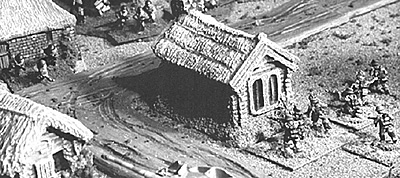In recent times, however, skirmish gaming (single troops and vehicles with individual crews) has made a comeback, due in no small part to the ever-increasing variety of troops and models available in 20mm and 25mm scale. In these skirmish games, of course, players represent, at most, squad or section leaders and their "armies" consist of a couple of squads of troops at most.
In just the last year-and-a-half or so, rules that focus on the battalion battle, with models representing sections of vehicles or guns, and stands representing squads or sections of infantry, have begun to become popular.
Players take the roles of battalion commanders and fight short, sharp actions to attain specific objectives (clear that crossroads; take that hill; etc.) using the squads and sections at their disposal. This "squad" level game fills a niche between the former rules for which a battalion battle is at the lower end of practicality (Too small a battle, too few troops on the table, too little fun!) and the latter skirmish rules for which anything larger than a platoon action frequently becomes impractical.
This article focuses on a single battalion-sized scenario dealing with the German counter-attacks against the Soviet Magnuszew Bridgehead across the Vistula in the late summer of 1944. It features replays of the scenario using three of the better-known of the new squad-level rules, Battlefront (BF), Tacfire (TF), and Point of Attack (PoA), as well as comparisons of the main features of each rule set, notes on how the scenario was developed, and some general conclusions about how the scenario "played" under each set of rules.
These three rule sets share the same basic game parameters: 40 - 50 yards per inch as a table scale, a stand of troops, model tank, or model gun represents a squad or section, and a turn represents 10 minutes (OK - PoA actually uses a 30 minute turn but their definition of "turn" is a bit different, so go figure…). The replays took approximately the same amount of "game time" to play - between one and two hours. I seem to recall saying this some time ago about platoon level rules, but given that the new squad level rules share the same general scales and address the same basic issues, they differ in almost all other ways! They approach the questions of how to play out a battle with squads and sections and what factors are important to the game in three very different ways. Though BF and TF have both been reviewed in these pages in past issues and PoA will be reviewed shortly, it's worthwhile to briefly recapture the three rule sets' significant features to show how they differ and how they're alike.
To the Vistula! WWII Rule Sets Reviewed
 Another sea change in the nature of WW II miniatures gaming has been underway in the USA for a couple of years now. Once upon a time, low-level tactical games, with models representing tanks or guns and stands representing squads or fire-teams, seem to have been the norm and "other" game scales were looked upon with some suspicion. This all began to change in the mid-late 1980s, though, with the introduction of Command Decision, Korps Kommander, Spearhead, Clash of Armor, and other rule sets that represented entire platoons with single models or a single stand of troops. These platoon level rules, for all of their differences, focused on a single theme - that of fighting an entire battle with a reasonable number of players, in a reasonable amount of time, and with reasonable spans of control (i.e., a single player isn't making decisions all the way from those of the platoon leader up through the division commander). In the ensuing years, this "level" of game has become almost the standard.
Another sea change in the nature of WW II miniatures gaming has been underway in the USA for a couple of years now. Once upon a time, low-level tactical games, with models representing tanks or guns and stands representing squads or fire-teams, seem to have been the norm and "other" game scales were looked upon with some suspicion. This all began to change in the mid-late 1980s, though, with the introduction of Command Decision, Korps Kommander, Spearhead, Clash of Armor, and other rule sets that represented entire platoons with single models or a single stand of troops. These platoon level rules, for all of their differences, focused on a single theme - that of fighting an entire battle with a reasonable number of players, in a reasonable amount of time, and with reasonable spans of control (i.e., a single player isn't making decisions all the way from those of the platoon leader up through the division commander). In the ensuing years, this "level" of game has become almost the standard.
Introduction
Battlefront
Tacfire
Point of Attack
Scenario: 5 August 1944 Overview
Scenario Replay: Battlefront
Scenario Replay: Tacfire
Scenario Replay: Point of Attack
Comparisons and Conclusions
Back to Table of Contents -- Courier #82
To Courier List of Issues
To MagWeb Master Magazine List
© Copyright 2001 by The Courier Publishing Company.
This article appears in MagWeb (Magazine Web) on the Internet World Wide Web.
Other military history articles and gaming articles are available at http://www.magweb.com